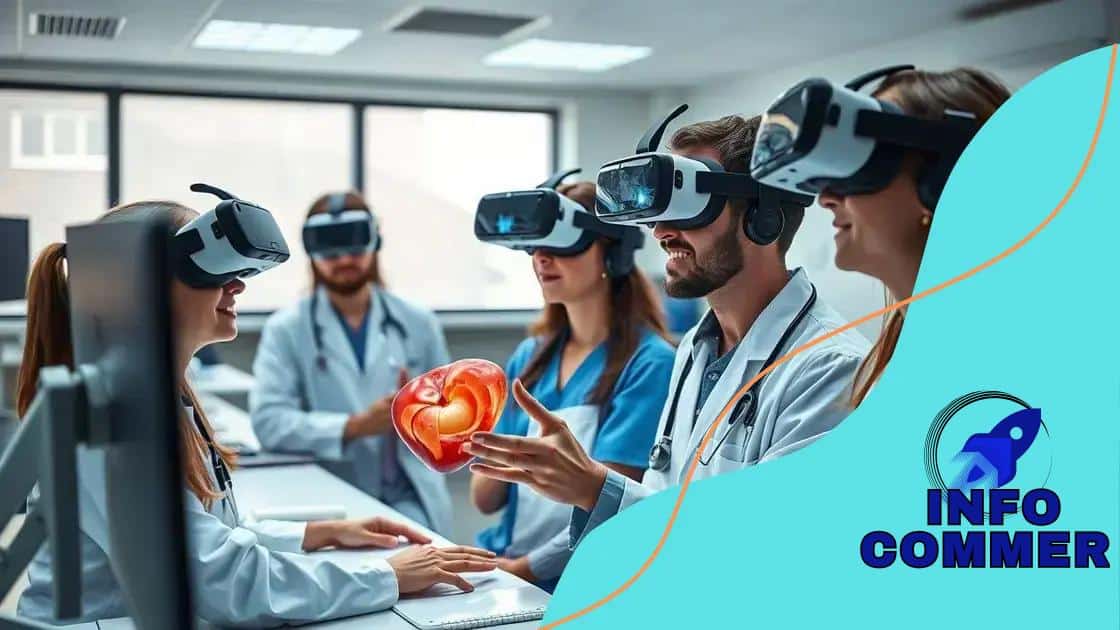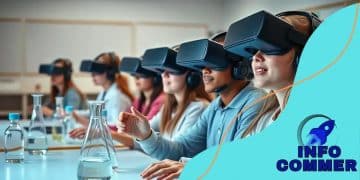Virtual reality’s role in training medical professionals

Virtual reality’s role in training medical professionals enhances practical skills through immersive simulations, preparing students for real-world scenarios and improving patient care outcomes.
Virtual reality’s role in training medical professionals is becoming increasingly significant. Imagine being able to practice complex procedures in a safe environment. Curious about how this technology reshapes medical education?
Understanding virtual reality in medical training
Understanding how virtual reality enhances medical training is essential for modern healthcare education. This innovative approach allows students to engage in lifelike simulations, preparing them for real-world challenges.
Benefits of Virtual Reality
One major advantage of virtual reality in medical training is the ability to practice without risk. Students can make mistakes and learn in a safe setting. This technology also promotes active learning, enabling quicker skill mastery.
- Immersive experiences improve retention.
- Real-time feedback enhances learning outcomes.
- Cost-effective training solutions are available.
Additionally, virtual reality caters to various learning styles. Some students benefit from visual experiences, while others prefer hands-on practice. This versatility makes it an invaluable tool.
Real-Life Applications
Healthcare providers have successfully implemented virtual reality training programs for different specialties. For instance, surgical residents can rehearse complex procedures in a realistic environment. Similarly, emergency response teams use simulations to practice high-pressure scenarios.
This technology not only helps with technical skills but also fosters better communication and teamwork among medical staff. By participating in virtual scenarios, trainees learn to collaborate effectively under stress.
Conclusion
As we embrace the future, understanding the role of virtual reality in medical training is crucial. It equips professionals with the tools they need to provide high-quality care.
Benefits of using virtual reality for medical practitioners
The benefits of using virtual reality for medical practitioners are notable and transformative. With this technology, healthcare workers can enhance their skills in a safe, controlled environment.
Enhanced Learning Opportunities
One primary advantage is how it provides enhanced learning experiences. Medical professionals can practice various procedures without the fear of harming a patient. This hands-on approach allows for mastery of techniques before real-world application.
- Improves procedural accuracy and confidence.
- Allows repeated practice until proficiency is achieved.
- Reduces the need for physical resources like mannequins.
Additionally, virtual reality can simulate complex scenarios that healthcare workers might face. These simulations prepare them for emergencies, improving their critical thinking skills and decision-making under pressure.
Cost and Time Efficiency
Virtual reality training also proves to be cost-effective in the long run. Institutions can save on costs associated with traditional training methods, such as hiring live instructors or purchasing extensive training equipment.
This technology enables institutions to train more personnel at once, providing a scalable solution for large healthcare systems. As training becomes more efficient, practitioners can spend valuable time focusing on patient care.
Cater to Different Learning Styles
Moreover, virtual reality caters to various learning styles. Visual learners benefit from immersive 3D environments, while kinesthetic learners engage through hands-on experiences. This adaptability ensures that all medical professionals receive optimal training.
By incorporating virtual reality into their training programs, healthcare institutions can create a more effective and inclusive learning environment. This approach not only enhances skill sets but also fosters a continuous learning culture.
Case studies showcasing virtual reality applications

Case studies showcasing virtual reality applications in medical training highlight its effectiveness and transformative impact on healthcare education. Several institutions have adopted this technology to enhance practical learning experiences.
Case Study: The University of Southern California
At the University of Southern California, medical students use VR simulations to practice surgical techniques. In these settings, they can view anatomical structures in 3D and hone their skills before they enter the operating room.
- Students enjoy increased confidence.
- Feedback mechanisms provide instant evaluation.
- Learning becomes interactive and engaging.
This method reduces typical anxiety associated with first-time procedures, allowing students to perfect their techniques in a low-stakes environment.
Case Study: Stanford University
Stanford University utilizes VR for training emergency response teams. Through realistic scenarios, participants experience high-pressure situations that improve their decision-making and teamwork.
These simulations allow participants to learn how to assess emergency situations quickly. By practicing in a virtual environment, they become better prepared for real emergencies.
Case Study: Ohio State University
Ohio State University integrates virtual reality into its nursing program. Nursing students engage in simulations that replicate patient care scenarios, including difficult conversations and emergency responses.
This training emphasizes communication and patient interactions, vital skills for future nurses. By engaging in these realistic simulations, students learn to navigate challenging situations effectively.
The immersive aspect of VR keeps students engaged, making learning enjoyable while reinforcing crucial healthcare skills.
Integrating virtual reality into existing medical programs
Integrating virtual reality into existing medical programs is enhancing how future healthcare professionals learn and train. This technology is becoming essential for effective education, providing a hands-on approach that traditional methods lack.
Curriculum Development
To successfully integrate virtual reality, schools need to adapt their curriculums. This involves collaborating with VR developers to create simulations that meet educational standards. By doing this, institutions can ensure that VR applications align closely with course objectives.
- Customize training scenarios for specific medical fields.
- Incorporate feedback from instructors and students.
- Evaluate the effectiveness through ongoing assessments.
Integration also allows for interdisciplinary learning. For example, medical students can work alongside nursing and pharmacy students in virtual environments, enhancing teamwork and communication skills crucial in real-life settings.
Training Educators
Another vital aspect is training educators on how to utilize VR effectively. Instructors must understand how to facilitate VR sessions and guide students through immersive experiences. With proper training, teachers can maximize the benefits of these technologies in their teaching methods.
Healthcare educators are encouraged to participate in VR workshops and continuous learning programs. This ensures they stay updated on advancements in VR tools and techniques, enabling them to provide the best instruction possible.
Implementation Challenges
Despite its benefits, integrating virtual reality also presents challenges. One common issue is the high initial cost of VR equipment and software. However, as technology advances, prices are becoming more affordable.
Additionally, institutions need to ensure adequate technical support to address any issues that arise during training. A seamless integration process is vital for maximizing the effectiveness of VR in medical education.
Future trends in virtual reality for healthcare education
Future trends in virtual reality for healthcare education are promising and indicate significant advancements. As technology evolves, so do the opportunities for enhancing training and education in the medical field.
Increased Accessibility
One major trend is the increased accessibility of virtual reality technology. As devices become more affordable, healthcare institutions can integrate VR into their training programs more easily. This allows for a wider range of medical professionals to benefit from immersive learning experiences.
- Improvements in VR hardware will lower costs.
- Mobile VR options will reach more users.
- Cloud-based solutions will ease implementation challenges.
This expanded access could lead to a more standardized level of training, regardless of location.
Advanced Simulation Capabilities
Additionally, advancements in simulation capabilities will enhance how scenarios are created. Future simulations will offer more realistic environments and patient interactions. By using AI within VR, educational programs can create unique scenarios tailored to the learner’s needs.
Realistic patient responses and complex medical scenarios can provide learners with deeper insights into patient care. This will not only improve clinical skills but also foster empathy and understanding of patient experiences.
Integration with Other Technologies
The integration of VR with augmented reality (AR) and artificial intelligence (AI) is another exciting trend. Combining these technologies will create hybrid training environments that amplify the effectiveness of education.
For example, AR can overlay essential information during VR simulations, enhancing the learning experience. AI can evaluate a learner’s performance and suggest personalized training paths, ensuring that each individual gets the support they need.
As these technologies evolve, the potential for revolutionary changes in medical education becomes more apparent. The future of virtual reality in healthcare education looks bright and filled with possibilities.
FAQ – Frequently Asked Questions about Virtual Reality in Healthcare Education
What are the main benefits of using virtual reality in medical training?
Virtual reality offers hands-on experience in a safe environment, allowing medical students to practice skills and improve confidence without the risk of harming patients.
How is virtual reality expected to change in the future for healthcare education?
The future of virtual reality in healthcare education includes increased accessibility, advanced simulation capabilities, and integration with other technologies like AI and AR.
Are there any challenges in integrating virtual reality into existing medical programs?
Yes, challenges include the high initial cost of VR equipment and the need for technical support to ensure smooth implementation and training.
How do educational institutions train instructors to use virtual reality?
Educational institutions often provide workshops and continuous learning programs to help instructors understand how to implement VR effectively and maximize its benefits.





